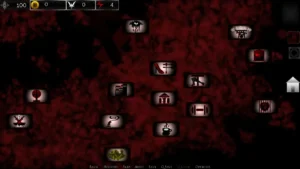
The Void of Deviance
Play The Void of Deviance
The Void of Deviance review
Exploring the narrative, mechanics, and artistic vision behind this unconventional indie title
The Void of Deviance stands as a distinctive entry in indie game development, challenging conventional narrative structures and player expectations. This unconventional title explores themes of transgression, identity, and psychological exploration through interactive storytelling. Whether you’re a seasoned indie game enthusiast or curious about experimental gaming experiences, understanding what makes this title unique requires examining its core design philosophy, narrative approach, and the creative vision driving its development. This guide provides comprehensive insights into the game’s mechanics, thematic elements, and what players can expect from this boundary-pushing experience.
Understanding The Void of Deviance: Core Concepts and Design Philosophy
Let me tell you about the first time I played a game that truly unsettled me. It wasn’t a horror title with jump scares, but something that lingered in my mind for days, challenging my perception of what a game could be. That’s the space The Void of Deviance occupies—a title that doesn’t just want to entertain you, but to provoke a profound internal dialogue. 🎭 If you’re tired of predictable storylines and formulaic gameplay, you’ve come to the right place.
This chapter dives deep into the heart of this remarkable project, unpacking the core concepts and the unique indie game design philosophy that makes it a standout title. We’ll explore how it uses narrative-driven gameplay mechanics to tell its story and why its approach to experimental interactive storytelling is so significant in today’s gaming landscape.
What Makes This Game Unique in Indie Development
In a market saturated with sequels and safe bets, The Void of Deviance feels like a breath of fresh, if slightly unsettling, air. 🌬️ Its uniqueness isn’t just a marketing hook; it’s woven into the very fabric of its creation. The developer behind the project stated:
“We weren’t interested in creating a power fantasy. We wanted to build a mirror. The goal was to craft an experience where players aren’t just controlling a character, but are actively confronting parts of themselves they usually keep hidden. The ‘game’ is merely the vessel for that confrontation.”
This statement cuts to the heart of its indie game design philosophy. It’s a project driven by a vision, not by market analytics. This commitment to a personal, artistic goal is what defines true indie game innovation. The game deliberately sidesteps conventional reward structures—there are no experience points to grind, no shiny loot boxes to open. Instead, your reward is deeper understanding, and your progression is measured in emotional and psychological revelation. 😲
The game’s foundation is built on a commitment to experimental interactive storytelling. It doesn’t present you with a story to witness; it constructs a narrative ecosystem for you to inhabit. Your presence and actions are the primary catalysts for the plot. This is a stark departure from games that treat storytelling as a cinematic interlude between gameplay segments. Here, the story is the gameplay.
Let’s look at how this philosophy translates into a tangible structure compared to more traditional titles:
| Design Element | Traditional Game Approach | The Void of Deviance’s Approach |
|---|---|---|
| Narrative Progression | Linear or branching paths based on major plot decisions. | An emergent narrative shaped by subtle behavioral choices, dialogue tones, and even hesitation. |
| Player Goals | Complete quests, defeat bosses, acquire gear. | Understand the world, reconcile internal conflicts, and determine the nature of “deviance” itself. |
| Failure State | Character death, game over screen, reload checkpoint. | Narrative consequences, altered relationships, and new, often more challenging, philosophical dilemmas. |
This table highlights a fundamental shift. The game isn’t about winning; it’s about being. This focus on psychological themes in gaming is not just a layer of flavor text. It’s the core mechanic. You navigate a world where the environment reacts to your emotional state, where characters don’t have fixed moral alignments but respond to the “moral scent” you give off through your decisions. It’s a brilliant, and frankly, brave piece of indie game innovation. 💡
Narrative Structure and Thematic Exploration
If you’re expecting a three-act structure with a clear climax and resolution, prepare to be challenged. The Void of Deviance employs what I can only describe as a “kaleidoscopic narrative.” 🔮 The story fragments and reassembles itself based on your journey, refusing to settle into a single, easy-to-digest shape. This is the essence of its experimental interactive storytelling—it trusts you, the player, to find your own meaning and coherence.
The narrative-driven gameplay mechanics are seamlessly integrated. For instance, the game’s dialogue system doesn’t offer you a list of pre-written responses. Instead, you construct replies from fragments of thought and emotion, which in turn shapes your character’s developing worldview. A choice to respond with “Fear” instead of “Anger” in an early encounter might completely change which characters trust you later, opening up entire story threads you would otherwise never see.
The psychological themes in gaming explored here are profound and, at times, deeply personal. The game confronts you with concepts like:
* The fluidity of morality and whether “good” and “evil” are meaningful concepts.
* The weight of memory and how we reconstruct our past to suit our present needs.
* The nature of consciousness and what it means to be an individual within a system.
These aren’t topics discussed in expository cutscenes. They are lived experiences. You don’t learn about the protagonist’s struggle with their past; you inhabit their memories, and your interactions with those memories determine whether they become sources of strength or anchors of despair. This creates a powerful, personal connection to the unconventional game narratives on display.
My own playthrough was a testament to this. In one pivotal moment, I was faced with a character who had betrayed my trust. The game presented me with a choice that wasn’t “Forgive” or “Punish,” but rather “Understand” or “Eradicate.” I chose “Understand,” which triggered a long, painful sequence where I had to walk through the memory of the betrayal from their perspective. It was uncomfortable, slow, and offered no immediate reward. Yet, it fundamentally altered the entire second half of my game, leading to an ending that felt earned and deeply resonant. This is the power of its narrative-driven gameplay mechanics in action. ✨
Player Agency and Interactive Storytelling
This brings us to the engine of the entire experience: player choice and agency. Many games pay lip service to this idea, offering the illusion of choice where the major story beats remain largely unchanged. The Void of Deviance dismantles this illusion. Your agency here is real, pervasive, and often carries a heavy cost.
The game’s approach to player choice and agency is microscopic. It’s not about choosing which faction to support in a war, but about how you choose to observe a quiet moment, the tone of an unspoken thought, or whether you confront a painful truth or let it lie. The game tracks these micro-decisions, building a complex profile of your “deviancy”—your departure from expected norms. This profile directly influences:
* Which characters are willing to interact with you.
* The visual and auditory design of the environments.
* The very options available to you in critical moments.
Here’s a concrete example of how this plays out:
| Player Action | Immediate Result | Long-Term Narrative Consequence |
|---|---|---|
| Repeatedly avoiding eye contact with a specific character during conversations. | The character’s dialogue becomes more formal and distant. | This character later refuses to vouch for you in a crucial trial, forcing you down a path of isolation and self-reliance. |
| Spending an inordinate amount of time examining mundane, “unimportant” objects in the environment. | No immediate feedback or reward pop-up. | The game begins to surface more environmental storytelling and hidden lore, suggesting your character has a curious, observant nature that the world recognizes. |
| Choosing to help a seemingly insignificant NPC with a personal task. | A brief, self-contained side interaction. | That NPC appears later as a surprise ally, providing a unique solution to a problem that would otherwise be insurmountable. |
This level of systemic, cause-and-effect storytelling is the pinnacle of experimental interactive storytelling. It makes the world feel truly alive and responsive to your unique presence. You aren’t just selecting from a menu of predetermined outcomes; you are co-authoring the story with the game itself. 🖋️
This profound player choice and agency is what makes the game’s psychological themes in gaming so effective. You aren’t being told that actions have consequences; you are living those consequences. A moment of cruelty, even if justified in your mind, can poison your relationships for hours of gameplay. An act of vulnerability can open doors you never knew existed. This transforms the experience from a passive pastime into an active, and often introspective, journey.
Ultimately, The Void of Deviance represents a bold step forward in indie game design philosophy. It demonstrates that games can be more than escapism; they can be a medium for profound exploration of the human condition. Its commitment to unconventional game narratives and deep, systemic player choice and agency challenges not only what we expect from games but also what we expect from ourselves as we play them. It’s a demanding, sometimes frustrating, but ultimately unforgettable experience that will change how you think about the potential of interactive art. 🎨
The Void of Deviance represents a significant moment in indie game development, demonstrating how interactive media can explore complex psychological and thematic territory. By prioritizing narrative experimentation and player agency over conventional gameplay mechanics, the title challenges what games can express and how players engage with interactive storytelling. The game’s approach to unconventional narrative structure, combined with its thematic depth, makes it a compelling study in how indie developers push creative boundaries. For players seeking experiences that venture beyond mainstream gaming conventions, The Void of Deviance offers a thought-provoking journey into experimental interactive fiction. Whether you’re interested in game design innovation, narrative experimentation, or simply exploring what contemporary indie games can achieve, this title deserves consideration as a distinctive voice in modern gaming culture.






























